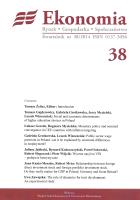Public sector wage premium in Poland: can it be explained by structural differences in employment?
Public sector wage premium in Poland: can it be explained by structural differences in employment?
Author(s): Gabriela Grotkowska, Leszek WincenciakSubject(s): Economy, National Economy
Published by: Uniwersytet Warszawski - Wydział Nauk Ekonomicznych
Keywords: wage; premium; public sector; private sector; Poland
Summary/Abstract: The public sector is commonly thought to offer relatively low wages, but neither statistics nor research for different countries justifies this belief. In general, the observed regularity is that the average wage in the public sector exceeds the average wage in the private one. The difference is sometimes quite substantial. The comparison of raw average wages suggesting higher wages for public sector would however be misleading. To a large extent, this premium can be attributed to the differences in the structure of employment in both sectors. The public sector employment is biased towards higher level of education and longer job tenures, which on the grounds of human capital theory explains the observed higher average wages in the public sector. The aim of this article is to find to what extent the observed difference in wages is a result of differentiated structure of employment. We use LFS data for Poland and a Mincerean wage regression with Heckman correction supplemented by a quantile regression to show that, after controlling for structural differences in employment, the public sector wage premium in Poland is negative.
Journal: Ekonomia. Rynek, Gospodarka, Społeczeństwo
- Issue Year: 2014
- Issue No: 38
- Page Range: 47-73
- Page Count: 27
- Language: English

